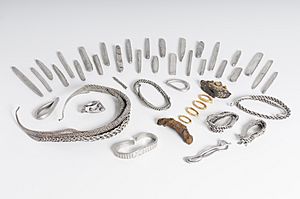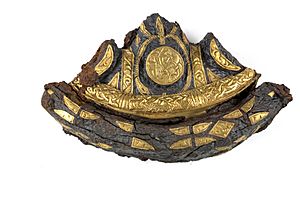Bedale Hoard facts for kids
Quick facts for kids Bedale Hoard |
|
|---|---|

The bedale hoard
|
|
| Created | 850-900 (deposited) |
| Period/culture | Viking |
| Discovered | 2012 Bedale, North Yorkshire |
| Present location | Medieval Gallery, Yorkshire Museum, York |
| Identification | YORYM: 2014.149 YORYM-CEE620 |
The Bedale Hoard is a special collection of forty-eight silver and gold items. These items date back to the late 800s or early 900s AD, during the exciting Viking Age. The hoard includes beautiful necklaces, arm-bands, a sword part called a pommel, and pieces of cut silver known as hacksilver, along with ingots (metal bars).
This amazing treasure was found on May 22, 2012. It was discovered in a field near Bedale, North Yorkshire, by people using metal detectors. They quickly reported their find through a program called the Portable Antiquities Scheme. Thanks to a successful public fundraising effort, the Yorkshire Museum was able to buy the hoard for £50,000. Now, everyone can see and learn about this incredible piece of history!
Contents
What's Inside the Bedale Hoard?
The Bedale Hoard holds forty-eight items made of silver and gold. Because of its age and value, it was officially declared 'treasure' under the Treasure Act 1996.
The hoard contains many interesting things:
- Twenty-nine silver ingots (metal bars).
- An iron sword pommel (the top part of a sword handle) decorated with shiny foil.
- Four gold hoops or bands from the sword's hilt (handle).
- Six small gold rivets (tiny fasteners).
- Four silver collars and neck-rings (one was cut into two pieces).
- One silver arm-band.
- One piece of a 'Permian' style ring.
- One silver penannular brooch (a type of pin).
The Amazing Sword Parts
A large iron sword pommel was found, along with its guard (the part that protects the hand). There were also four gold hoops from the sword's hilt and six small gold rivets.
The pommel is shaped like a triangle. It is decorated with gold foil plaques that have detailed animal designs. These designs have jagged edges and are in a style called Trewhiddle style, which was popular in the late Anglo-Saxon period (late 800s). This type of pommel is known as Petersen's type L. Usually, sword pommels from this time were decorated with silver. The large amount of gold foil used on this pommel makes it very special and unique!
Beautiful Neck-rings
The largest neck collar in the hoard is made of four twisted silver cables. Each cable is a different size and they are hammered together at the ends. The outer cable is made of six thick, braided rods. The three inner 'hollow' ropes are each made of three coiled strands of double-twisted rods. While parts of this collar have been seen before, this specific 'West Viking' style is one-of-a-kind.
The hoard also shows how much trade happened long ago. A piece of a 'Permian' style ring was found, which came all the way from Russia! This shows that Vikings traded across long distances. There are also two complete neck-rings made of six braided cables. Another neck-ring, made of three strands, was cut in half. This was likely used as hacksilver, which was silver cut into pieces to be used as money.
Silver Ingots
The hoard included twenty-nine silver ingots (metal bars). These ingots have small amounts of other metals mixed in. Many of them have little nicks or cuts, which were probably made to test the purity of the silver. Three of the ingots even have crosses carved into them. Their weights range from about 40 grams to 146 grams.
Why is the Hoard Important?
The Bedale Hoard tells us a lot about how connected the world was in the Early Middle Ages. It shows influences from Russia and Ireland, mixed with Anglo-Saxon and Anglo-Scandinavian styles.
What's also interesting is that this hoard doesn't have any coins. This suggests that in the late 800s AD, people often traded using the weight of precious metals, like silver, instead of coins. The Bedale Hoard is older than two other famous Viking treasures: the Cuerdale Hoard and the Vale of York Hoard.
Where to See the Hoard
The Bedale Hoard was first put on permanent display at the Yorkshire Museum in 2014. Since 2017, it has been part of a special traveling exhibition called 'Viking: Rediscover the Legend'. In this exhibition, it is shown alongside the Vale of York Hoard and the Cuerdale Hoard. The tour started at the Yorkshire Museum and has traveled to places like the Atkinson Art Gallery and Library in Southport, Aberdeen Art Gallery, Norwich Castle Museum, and the University of Nottingham.



